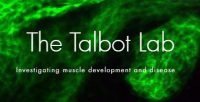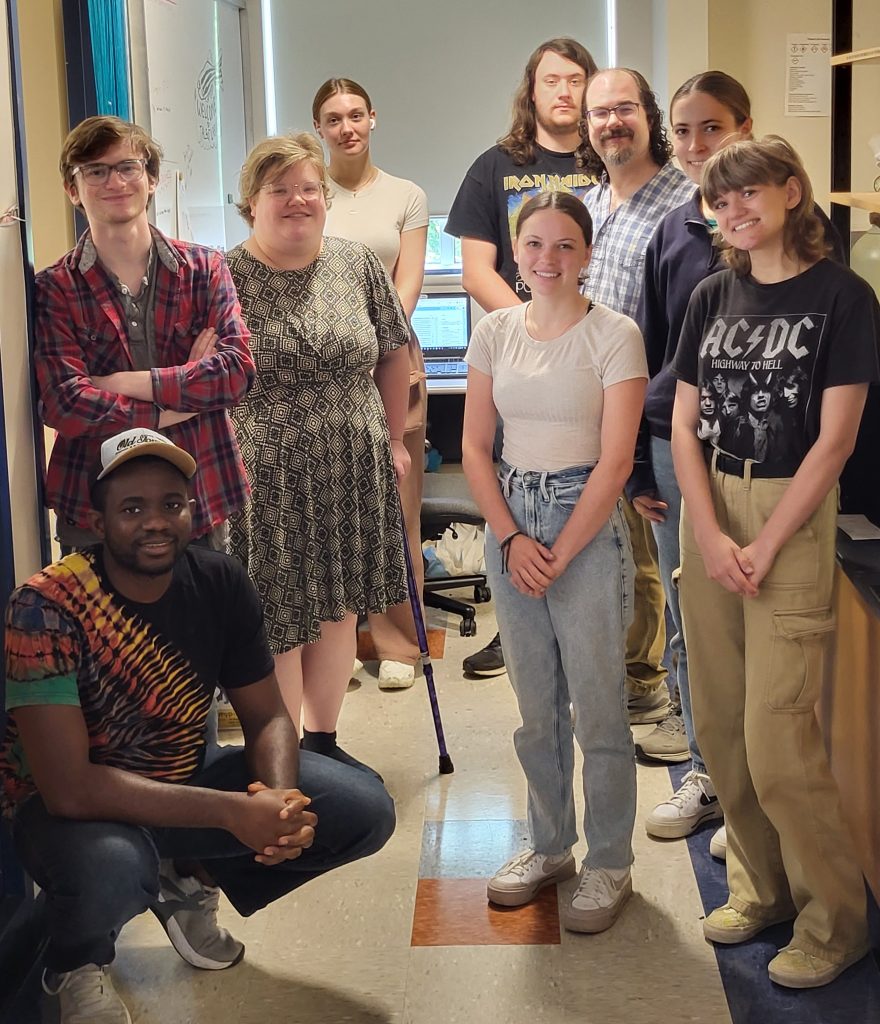
The Talbot Lab finds strength in collaborative research
Science is often portrayed as a solo researcher working long into the night in the pursuit of their world changing result, but we feel that this doesn’t reflect what actually happens, especially not in the Talbot Lab. Our group focuses on research that advances understanding of how muscles are positioned in the body and how they grow in strength through time. This summer, our group has been incredibly active with a large team of students, technicians, and the PI (Jared Talbot, Assistant Professor) supporting one another to achieve these goals as one lab in the COBRE community. Every Talbot lab member works together with other researchers to get the job done and we find that mutual support and community building are key to accomplishing our research goals.

Left- Tayo Adekeye, Mason Soares, Teresa Easterbrooks, Maddie Coffin
Center – Angelina White
Right- Jordan Roamer, Rebecca White, Jared Talbot,Troy Hupper
Absent (but in article)- Amin Foroughi Nezhad
It’s hard to name a single person who acts alone – instead, our experiments proceed through an interlocked web of expertise. For example,Tayo Adekeye (PhD student, SBE) investigates how a gene called Mylpf impacts muscle formation as part of a team of students. Tayo mentors three undergraduates in the lab, each with their own projects that work together to produce a mosaic of knowledge.
This summer, Maddie Coffin (Senior Biology major) joined the project, and seeks to identify how the timing of protein expression influences Mylpf activity. Tayo and Maddie work together on experiments like athletes passing a baton. Maddie collects and cares for embryos, then Tayo steps in for step he has trained on extensively, before passing animals back to Maddie for further analysis. Maddie’s own work springs from a project pioneered by a previous undergraduate, Sadie Waterman (Graduated 2023). By refining Sadie’s protocol, Maddie and her team achieved clearer results, reflecting how these ‘batons’ can be passed passes can across years of work. Maddie credits the genotyping she needed for her experiments to the support of another student, Mason Soares (Senior, Microbio major). In turn, Mason often works with Troy Hupper (Senior, Bio major) and Jordan Roamer (Junior, Marine Science major) to share space and time using the PCR equipment for their own pieces of the project, so everyone can get good genotyping results quickly.
This collaborative spirit is echoed by Jordan, who finds working in the lab calming and enjoys the sense of responsibility. As a lab technician, Jordan takes on a variety of maintenance tasks, from cleaning and organizing data with Becca White (Senior, high school) to genotyping and stock maintenance. These two technicians have been trained and supported by our lab manager Teresa Easterbrooks (M.Sc., 2023), who ensures that all reagents are ready at the time they’re needed. Their contributions, though often behind the scenes, are crucial to experimental success. The achievements of our group are the result of skills and talents of numerous bright minds, who each layer in the foundations of progress.
This support structure also allows for specialization in work across career stages. For instance, Angelina White (Junior, Biology) has developed refined methods for examining gene expression quickly and at high resolution, which she uses to advance every other project in the lab. A new graduate student Amin Foroughi-Nezhad (PhD, SBE) is bringing new informatic perspectives to the team. Dr. Talbot does his own baton-passing steps, coming into experiments, taking the lead at key points such as microscopic imaging. He says “It’s a bit like when a surgeon arrives, gloves up, adds the final stitches, and passes a patient back to the operating team.” This kind of experimental involvement excites him because it lets him do the hands-on work that he loves, while preserving time for research planning, all without compromising the students’ ownership of their experiments. Dr. Talbot is himself supported by other researchers in the COBRE team, who meet weekly to discuss obstacles and possibilities in their research programs. Each of the students in the Talbot Lab has their own project this summer – and yet each finds themselves thanking and being thanked by others in the group about how they’ve aided in the success of projects that they don’t “own”. We know that many labs run exactly like this – but it is a joy to see it work so well. We posit research works best when it grows from mutual generosity, because the seeds of success are found when intertwining stories grow together.
